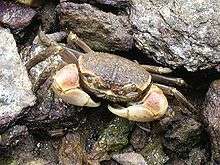Chasmagnathus
For the crab species also originally described as Ocypode convexus, see Golden ghost crab.
| Chasmagnathus | |
|---|---|
 | |
| Scientific classification | |
| Kingdom: | Animalia |
| Phylum: | Arthropoda |
| Subphylum: | Crustacea |
| Class: | Malacostraca |
| Order: | Decapoda |
| Infraorder: | Brachyura |
| Family: | Varunidae |
| Genus: | Chasmagnathus De Haan, 1833 [1] |
| Species: | C. convexus |
| Binomial name | |
| Chasmagnathus convexus (De Haan, 1835) [1] | |
| Synonyms [1] | |
| |
Chasmagnathus convexus is a common mud-flat crab of the family Varunidae, which is endemic to East Asia.[2][3] In Japan, this crab is commonly called hamagani. This crab has two forms that differ in color; one is olive green and the other is purple.[2] Differences in diet are believed to be responsible for the color variation between the two forms. C. convexus is large, relative to related crabs, and can reach 4.5 to 5 centimetres (1.8 to 2.0 in) wide across its carapace.[4] It is predominantly nocturnal.[2]
References
- 1 2 3 Peter K. L. Ng; Danièle Guinot; Peter J. F. Davie (2008). "Systema Brachyurorum: Part I. An annotated checklist of extant Brachyuran crabs of the world" (PDF). Raffles Bulletin of Zoology. 17: 1–286. Archived from the original (PDF) on 2011-06-06.
- 1 2 3 Hsi-Te Shih; Hiroshi Suzuki (2008). "Taxonomy, phylogeny, and biogeography of the endemic mudflat crab Helice/Chasmagnathus complex (Crustacea: Brachyura: Varunidae) from East Asia" (PDF). Zoological Studies. 47 (1): 114–125.
- ↑ Katsushi Sakai (ed.). "Chasmagnathus convexus". Crabs of Japan. Retrieved January 16, 2009.
- ↑ Hitoshi Miyasaka; Motomi Genkai-Kato; Yukiko Goda; Koji Omori (2007). "Length-weight relationships of two varunid crab species, Helice tridens and Chasmagnathus convexus, in Japan" (PDF). Limnology. 8 (1): 81–83. doi:10.1007/s10201-006-0195-8.
This article is issued from Wikipedia - version of the 11/20/2016. The text is available under the Creative Commons Attribution/Share Alike but additional terms may apply for the media files.